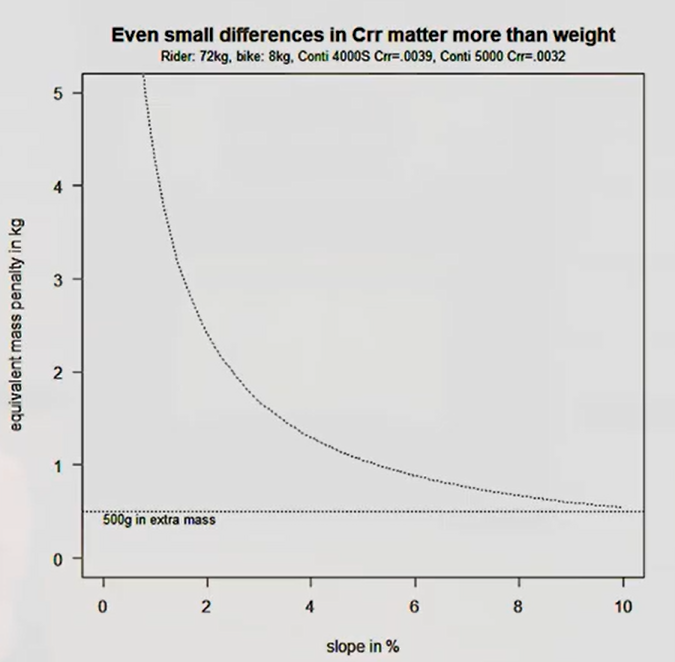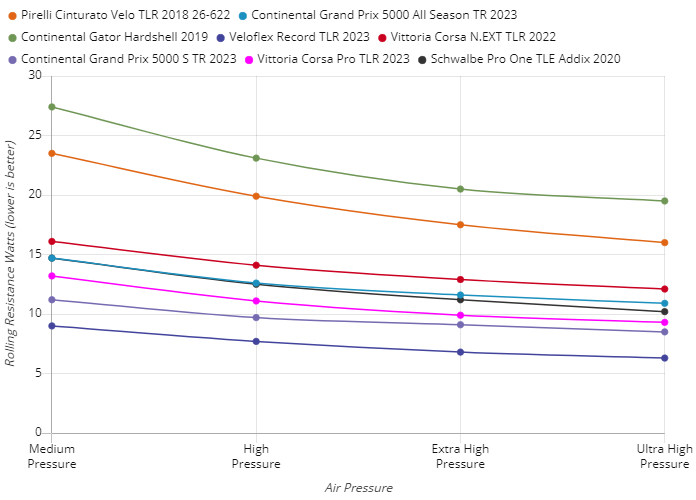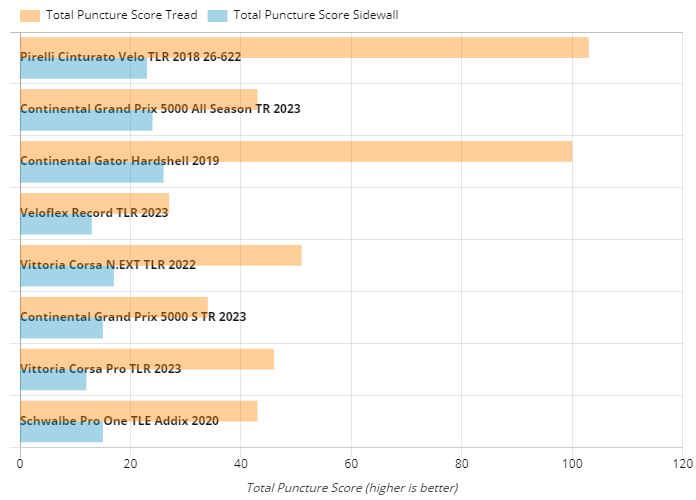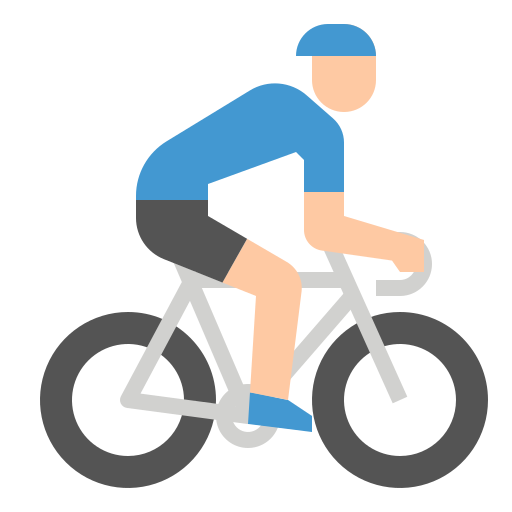By switching to a faster road bike tire, you can significantly boost the performance of your setup. For instance, upgrading from the old Continental GP4000 SII to the latest GP5000 S TR can feel like shedding 1-2 kilograms of weight, even when cycling up gradients of 6° or more. This is primarily due to the impressive reduction in tire rolling resistance, especially if you opt for a tubeless setup. However, it’s worth noting that the fastest tires are also more prone to punctures, so selecting a sturdier training or winter tire for these situations may make sense.
Are tires such a relevant upgrade?
Following the posts on the fastest tires and the fastest alternatives to tubeless, some people asked if the effort around road bike tires is worth it and if the differences are really that meaningful? In short: yes. Most importantly, rolling resistance appears much more relevant than weight, which cyclists still tend to focus on. What’s more, the improvements in rolling resistance in the last couple of years have been quite significant and probably underappreciated, as the following examples will show.
Faster tires are always faster
The question of relevance is never easy to answer and one we will often ponder in this blog. The theoretical best setup is highly dependent on many parameters, from bike setup, rider physiology, race tactics, race course, financial means, and many others. Often, if you start optimizing one parameter, for example, weight, you may diminish the ability to produce power, making these trade-offs quite complex to navigate. Here is where rolling resistance and drive train efficiency are so beautiful: faster bike tires are always faster. Whether you go up or down, whether you ride slow or fast, whether it’s road, gravel or track. Even more importantly, faster tires do not influence power production or aerodynamics (mostly) and are a relatively simple upgrade. As such, any improvements we cover in our “Roll Faster” section will be beneficial in almost any scenario.
Picking the right setup means making many compromises and trade-offs, especially when it comes to rolling resistance. Fast tires always perform better, whether you’re going uphill, downhill, cruising, or racing. It’s a no-brainer upgrade!
In the following paragraphs, we will explore the relevance of rolling resistance compared to weight to gain some understanding of the importance of such a relatively simple upgrade.
The physics of rolling resistance in cycling
Rolling resistance is essentially the amount of energy that is lost as the tire moves over the pavement. In another article on the fastest tires, we have covered it in a deep dive. Here we are primarily interested in the relation between power and factors that affect rolling resistance which one can influence with gear choice.
Below is the simplified formula and the influence factors on the power required to overcome rolling resistance. If you want to dig a little deeper, we recommend another great video from Silcas Josh Poertner.
P_{rr} = G \times W_{kg} \times C_{rr} \times VAlmost self-explanatory, these forces work against the power needed to push an object against friction.
- G = Simplified. The gravitational force from the earth’s gravity also increases with the road’s gradient. Easy to imagine it’s more challenging to push something uphill than on a flat road.
- W = Weight of the rider and bike system. This is logical as well; it takes more power to move a heavy object than a light object.
- Crr = The coefficient of rolling resistance of the system, meaning the inherent ability to move the system. Generally, pneumatic tires and wheels are very efficient, but some tires are more efficient than others. Here is where tire choice comes into play; faster tires have lower Crr values.
- V = velocity, the speed one wants to achieve, the faster you want to move, the more power is required.
The relationship between rolling resistance, weight, speed and power is linear
Below, you can see three plots for a typical cycling speed of 20 mph (32 km/h) and the change in power required at different Crr values (think various tires) on a flat surface. Every line represents a different weight of the system (rider and bike) at 200 lbs (90 kg), 160 lbs (72.5 kg) and 115 lbs (52.2 kg). Evidently, some pretty extreme differences in weight and not quite sure how many people weigh about 45 kg for the lightest setup with a 7.2 kg bike?
First, the relationships are linear, hence the lines in the graph. But how does this relate to tire choice?

For some context, here are some Crr values of popular tires at 60 PSI (4.1 bar) from bicycle rolling resistance:
- Continental GP5000 S TR (tubeless): 0.00303
- Continental 4000 S II (butyl tube): 0.00465 (+ 53%)
- Continental Ultra Sport III (butyl tube): Crr 0.00582 (+ 92%)
Switching to a better tire is the equivalent of losing almost 40 kilograms on the flat
As you can see, the Crr values may be small, but the relative differences are very significant. For example, the rolling resistance was almost halved between the older, cheaper Ultra Sport III and the latest GP 5000 S TR! Consequently, as you can see in the graph, if the 200 lbs (90 kg) rider switches the tire from GP 4000 S II to GP5000 S TR (moving left on the x-axis), that is approximately the equivalent of losing a whopping 85 lbs (38.6 kg)! That is true, but it is also “just” 15 watts at 32 km/h because weight doesn’t matter much on a flat surface.
Similar data in a different experimental context can also be found at Bicycle Rolling Resistance in a special article that looks at Crr variations under various loads. If you have the Pro membership, you can extract Crr data for different tires and the corresponding effects of weight.
Add a bottle to your faster tire and be still faster up to a 10% gradient
The next graph was made by Robert Chung, which I copied from this video from Josh Poertner to further illustrate the power of rolling resistance. Here a rider and bike weighing 80 kg are taken, and the difference in Crr between the Continental 4000S and the Continental GP5000 (older versions) are used as a basis and are effectively converted into a slope (both with latex tubes). Explaining the concept fully would require delving further into the mathematics, but essentially, the dimensionless nature of Crr allows for the creation of an informative graph.

On the y-axis is the mass in kilograms, and on the x-axis is the corresponding slope. The horizontal line at 500 g (equivalent to a small, lightweight water bottle) intersects with the Crr difference of GP4000 vs. GP5000 at a gradient of 10%. This means with the faster tire you can add 500 g to your setup and have the same speed. At 6%, this becomes around 1 kg and at 2% over 2 kg. You can also see how at 0% slope, hence flat, the graph rises way out of the chart to around the 40 kg we calculated above.
Switching from the old Continental GP4000 to the new GP5000 is like taking a 500 ml bottle off your bike while going up a 10% slope! If the slope is only 6%, it’s like taking off 2 bottles and still going the same speed.
Make tire choice a priority, especially before weight optimization
Hopefully, by now, you will be convinced of why tire choice is so relevant. Switching to the fastest tire setup will make you faster in almost any situation with virtually no influence on other gear choices and without the complexity of aerodynamics. The effect can be pretty dramatic, given the recent improvements in tire technology. Before you resort to starving yourself or spending a lot of money on lightweight components, consider optimizing your tire setup first. This is particularly important because the total weight of the rider and bike affects the overall system weight. Therefore, saving a few grams here and there may not make a significant difference in terms of percentage. To make this perfectly clear, if you can somehow manage to reduce bike weight by 400 grams, that is just a measly 0.5 % of a typical 80 kg rider and bike system!
However, there is a balance to be struck between puncture resistance and practical usage. Both contradict each other because more puncture resistance often means more material and energy loss.
Instead of starving yourself or splurging on expensive lightweight components, try tweaking your tire setup first. The difference can be pretty significant, especially with the recent advancements in tire technology.
Tubeless is the fastest, but it is not always practical, and you can consider your options in our article about tubeless alternatives. For tires, below is a selection of tubeless road tires that were chosen across the spectrum from fastest to most puncture-resistant, which generally appear to be leading in their respective category.


From the fastest to most puncture-resistant tires, choose the best option for your purpose
One of the fastest tires often cited is the Veloflex Record TLR. It has very low puncture resistance and may be best used on the track with a latex tube. There are a couple of time trial tires with similar performance.
Next are Continental GP5000 S TR and Vittoria Corsa Pro TLR, the current fastest tires for road racing and probably most beneficial for many if you care mostly about speed.
If you are looking for a little more puncture protection, opt for the Continental GP 5000 AS TR, the Schwalbe Pro One and the Vittoria Corsa N.EXT. Each offers a little more puncture protection at the expense of speed.
Consider the Continental Gator Hardshell for winter cycling and highest puncture protection, but be aware of its higher rolling resistance. Finally, the Pirelli Cinturator Velo may be an optimal alternative as it offers high puncture protection and significantly lower rolling resistance.
 Made me Slower
Made me Slower
 Same, Same
Same, Same
 Made me Faster
Made me Faster









